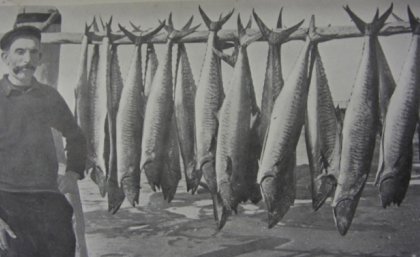.jpg?itok=3Yj1ddEA)
Catch rates of east coast Spanish mackerel have declined by 70 per cent over the past 80 years.
The ARC Centre of Excellence for Coral Reef Studies and University of Queensland have documented the decline by combining data from historical newspapers with fisher memories to reconstruct a 103-year record of the Queensland east coast Spanish mackerel spawning fishery.
UQ PhD graduate Dr Sarah Buckley, of the Sea-Fisheries Protection Authority in Ireland, said the decline had had substantial consequences.
“For the past 20 years the Cairns fishery has been commercially extinct and the Townsville spawning aggregations have remained completely offshore,” she said.
UQ School of Biological Sciences and ARC Centre for Excellence for Coral Reef Studies researcher Professor John Pandolfi said the conservation of spawning aggregations of fish was one of a suite of management tools that could contribute to healthy fish populations.
“Managers need to consider increased protection of Spanish mackerel during this critical time if it is hoped that catch rates can be increased,” Professor Pandolfi said.
Spanish mackerel are large and important recreational and commercial fish found in Queensland and northern New South Wales waters.
They form huge aggregations for breeding purposes at discrete Great Barrier Reef locations for a confined period of time each year.
.jpg) The research team said the fishery started more than 100 years ago, but official commercial catch and effort were not recorded by the government until the 1980s, leaving large gaps in the understanding of long-term changes in fish spawning aggregations.
The research team said the fishery started more than 100 years ago, but official commercial catch and effort were not recorded by the government until the 1980s, leaving large gaps in the understanding of long-term changes in fish spawning aggregations.
The scientists interviewed commercial fishers about their memories of changes to catch, gear and technology and locations fished, to reconstruct a comprehensive record.
Former UQ researcher Dr Ruth Thurstan, now at Deakin University, said Spanish mackerel fishers were able to recall fishing from as early as the 1940s, providing a wealth of knowledge that could be used to plug historical data gaps.
Preventing the decline and loss of fish spawning aggregations is a priority for the Great Barrier Marine Park Authority, and the research is being used by the Queensland Government to inform stock assessment.
Professor Pandolfi will present on the ‘Subtropical bleaching event along the eastern Australian coastline’ at the Coral Reef Futures Symposium 2017 in Canberra this week.
The research is published in Conservation Biology: the Journal of the Society for Conservation Biology. http://doi.org/10.1111/cobi.12940.
Media: Professor John Pandolfi, ARC Centre of Excellence for Coral Reef Studies and UQ, j.pandolfi@uq.edu.au, +61 (0) 400 982 301; Dr Sarah Buckley, sarah.buckley@sfpa.ie, +353 97 567 5487; Dr Ruth Thurstan, r.thurstan@deakin.edu.au, +61 0450 586 263.
.jpg)












